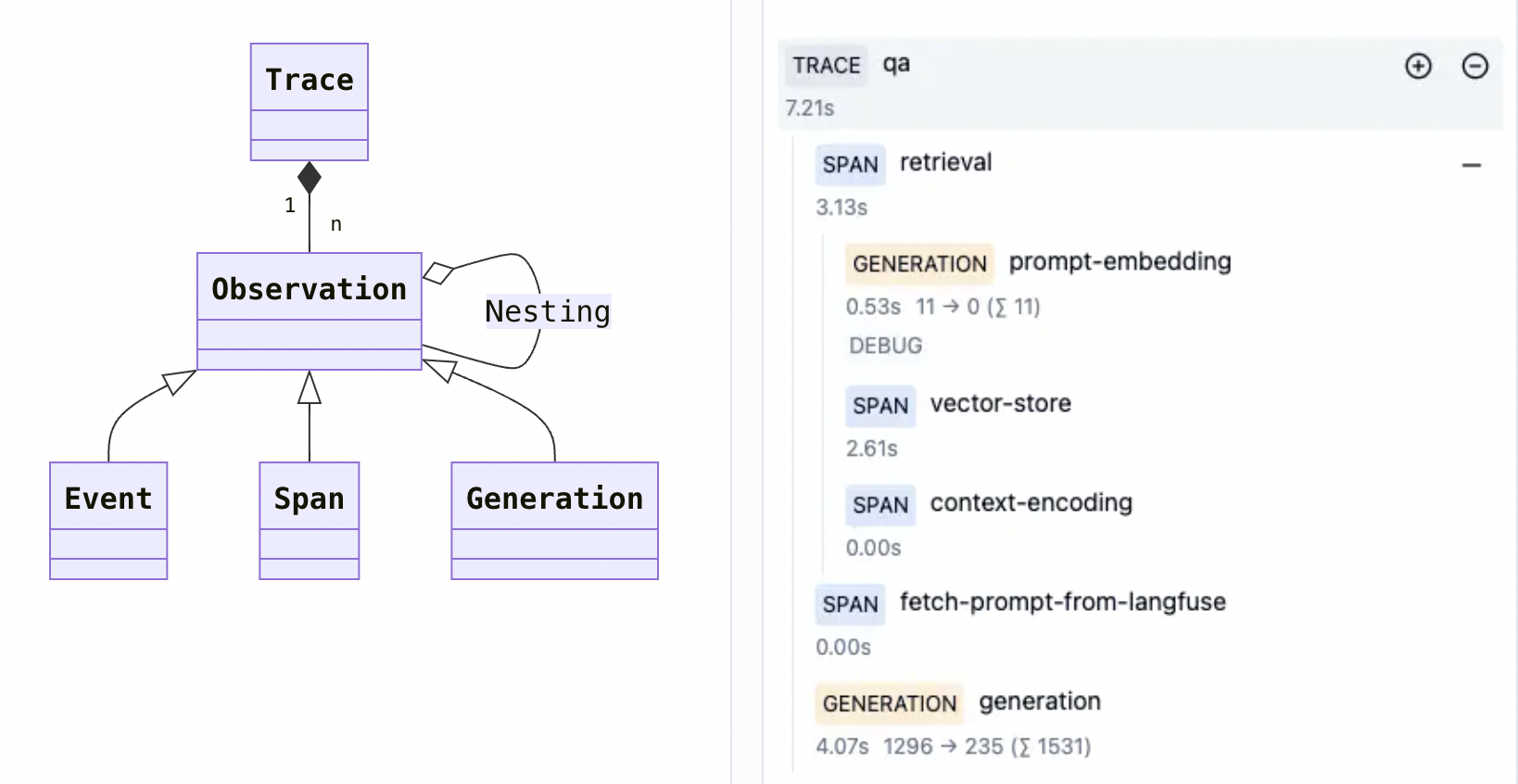Langfuse Tracing API
主要概念
主要的对象有:
- trace: 通常表示单个请求或操作。它包含函数的整体输入和输出,以及有关请求的元数据,例如用户、会话和标签。
- observation:每个 trace 可以包含多个观察结果,以记录执行的各个步骤。它可以嵌套。不同的 observation 类型:
- event:事件是基本构建块。它们用于 trace 中的离散事件。
- span:表示 trace 工作单元的范围。
- generation:用于记录大模型。它们包含模型名、Prompt、Output、Token 用量等。
类图:

主要有这几个接口
跟踪内容如:
console
TRACE
|
|-- SPAN: Retrieval
| |
| |-- GENERATION: Vector DB Query Creation
| |
| |-- SPAN: Data Fetching
| |
| |-- EVENT: Data Summary Creation
|
|-- GENERATION: Output Generation对应的使用的接口:
python
trace = langfuse.trace(name = "llm-feature")
retrieval = trace.span(name = "retrieval")
retrieval.generation(name = "query-creation")
retrieval.span(name = "vector-db-search")
retrieval.event(name = "db-summary")
trace.generation(name = "user-output");使用 API 示例
安装 langfuse
bash
pip install langfuse配置 langfuse 相关 sdk key 请看:Langfuse 快速开始的环境准备
使用 langfuse api 上报 trace
python
import os
import time
from dotenv import load_dotenv
from dashscope import Generation
from langfuse import Langfuse
from langfuse.client import StatefulTraceClient
# 加载 .env 配置文件的内容
load_dotenv()
langfuse_sdk = Langfuse()
def tongyi_generation(messages: list[dict], trace: StatefulTraceClient) -> str:
model_name = "qwen-plus"
generation = trace.generation(
name="Tongyi-generation"
, model=model_name
, input=messages
)
response = Generation.call(
# load_dotenv() 已从 .env 文件读的,可以直接使用。
api_key=os.getenv("DASHSCOPE_API_KEY"),
# 模型列表:https://help.aliyun.com/zh/model-studio/getting-started/models
model=model_name,
messages=messages,
result_format="message"
)
if response.status_code == 200:
output = response.output.choices[0].message.content
generation.end(
output=output
, usage={
"input": response.usage['input_tokens']
, "output": response.usage['output_tokens']
, "unit": "TOKENS"
}
)
return output
else:
tip = "请参考文档:https://help.aliyun.com/zh/model-studio/developer-reference/error-code"
raise Exception(f"HTTP返回码:{response.status_code};错误码:{response.code};错误信息:{response.message}。{tip}")
def tongyi_completion(input_query: str) -> str:
messages = [
{'role': 'system', 'content': '你是小学语文老师。'},
{'role': 'user', 'content': input_query}
]
trace = langfuse_sdk.trace(
name="tongyi-langfuse-api"
, input=messages
)
output = tongyi_generation(messages, trace)
trace.update(output=output)
return output
if __name__ == '__main__':
query = '请用50个字描写春天的景色。'
r = tongyi_completion(query)
print(r)
print("等待 5 秒,等待 langfuse 异步上报。")
time.sleep(5)
if langfuse_sdk:
langfuse_sdk.shutdown()
print("end!")效果如图:
